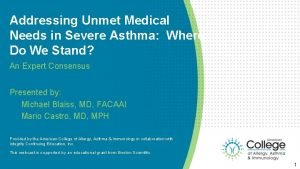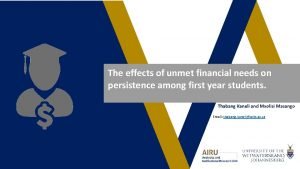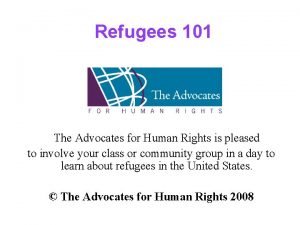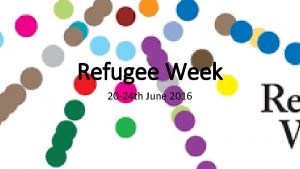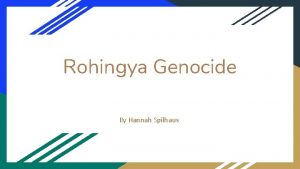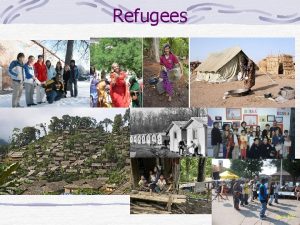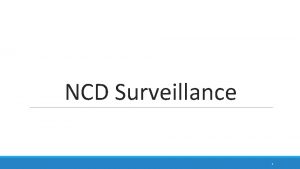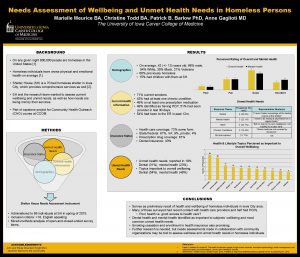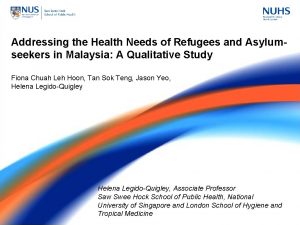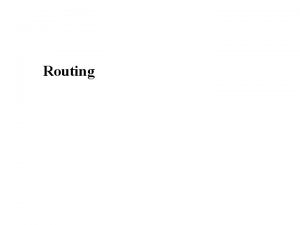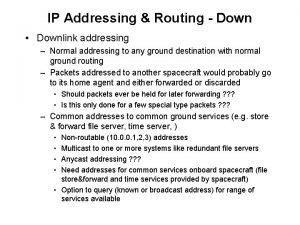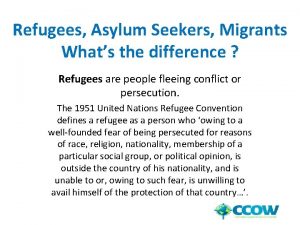Addressing unmet NCD needs of Rohingya refugees in













- Slides: 13

Addressing unmet NCD needs of Rohingya refugees in Malaysia Sok Teng TAN sokteng. tan@nus. edu. sg A dissertation project to fulfill MSc: Global Health and NCDs requirements with the University of Edinburgh Author list Sok Teng Tan 1 Karim Mitha 2 Helena Legido-Quigley 1, 3 1 Saw Swee Hock School of Public Health, National University of Singapore 2 University of Edinburgh 3 London School of Hygiene and Tropical Medicine 1

Rohingya refugees in Malaysia Formal employment Formal Education Refugees with chronic condition and ability to access care 24% refugee HH reported at least one person with NCDs 26% of them were unable to access care 2

Part 1 – Literature Review Databases Medline, Embase, Global Health (Ovid), Global Health (WHO), Web of Science Timeline After duplicates removal n = 1, 677 January 1990 – January 2017 Eligibility § NCD prevention, care and control measures § Adult refugees or asylum-seekers or migrants or urban poor or poor; § Protracted situation; § Low-resource setting; § English Language. Turning Discovery into Healthier Communities Included studies n = 10 Identified interventions n=3 3 3

Part 2: Applicability & Transferability Social Acceptability Available essential resources Political Acceptability or leverage Organisation al expertise and capacity Magnitude of health issues locally Applicability Potential Benefits Magnitude of the “reach” and cost effectiveness Target population characteristics Transferability Potential Harms Equity Considerations Associated Costs Buffett C, Ciliska D, Thomas H. Can I use this evidence in my program decision? National Collaborating Centre for Methods and Tools; 2007. 4

Identified intervention NCD Awareness and prevention Adherence Supports Community Health Workers Treatment Support (Navigating the health system) Non-invasive risk assessments Referral for diagnosis 5

Part 3: Identify an effective implementation strategy Recipients Level Existing literature Providers Level Barriers and Facilitators Other stakeholders Strategy Health System constraints Social and Political Constraints The SURE Collaboration. SURE Guides for Preparing and Using Evidence-Based Policy Briefs. Version 2. 1. 2011. http: //epoc. cochrane. org/sites/epoc. cochrane. org/files/public/uploads/SURE-Guidesv 2. 1/Collectedfiles/sure_guides. html. Accessed 23 Feb 2017. 6

Part 3 - Results Barriers and facilitators to implementation & proposed implementation strategies Establish effective multi-sectoral partnerships Social and cultural factors CHW’s competency Target population’s receptiveness Legislative limitations Regular supervision & refreshers Effective partnerships Establish an efficient referral mechanism Implementation Strategy Finances Resources and expertise Capitalise on international expertise and resources Recruit CHWs from the Rohingya community Regular supervision and refreshers Ensure CHWs’ competency before deployment 7

Discussion • Other studies suggested: – CHWs are effective in reaching hard-to-reach population (Swider, 2002) – Cost effective (Brown et al. , 2012; Gaziano et al. , 2014; Vaughan et al. , 2015) – CHWs are able to carry out community-based primary health services in humanitarian emergency (Sethi, Jonsson and Skaff, 2017) 8

Discussion • Matching study population – Rohingya population’s characteristics – Legislative limitations • Multifaceted health inequities – Paucity of literature on Rohingya and refugee’s NCDs – Academics/Researcher’s responsibility? 9

Conclusion • CHWs could potentially be effective • Wider social environment • Official status • Formal employment and education • Equitable policies • Affordable & appropriate healthcare • To strengthen refugee’s capacities in seeking care 10

Thank you! sokteng. tan@nus. edu. sg 11

References 1. Human Rights Watch. “All You Can Do is Pray” - Crimes Against Humanity and Ethnic Cleansing of Rohingya Muslims in Burma’s Arakan State. New York: Human Rights Watch; 2013. 2. Reynolds S, Hollingsworth A. Malaysia: Rohingya Refugees Hope for Little and Receive Less. Washington D. C. : Refugees International; 2015. 3. The Equal Rights Trust. Equal Only in Name: The Human Rights of Stateless Rohingya in Malaysia. London: Stroma Ltd; 2014. 4. UNHCR. Submission by the United Nations High Commissioner for Refugees For the Office of the High Commissioner for Human Rights’ Compilation Report – Universal Periodic Review: Malaysia. 2013. 5. Lee HA. Let refugees work legally. Malay Mail Online. 2016. http: //m. themalaymailonline. com/what-youthink/article/let-refugees-work-legally-lee-hwok-aun. 6. Bernama. Malaysia’s the fattest country in Asia, so why aren’t we spending on our health? News Straits Times. 2016. https: //www. nst. com. my/news/2016/10/179844/malaysias-fattest-country-asia-so-why-arent-we -spending-our-health. 7. Ng M, Fleming T, Robinson M, Thomson B, Graetz N, Margono C, et al. Global, regional, and national prevalence of overweight and obesity in children and adults during 1980– 2013: a systematic analysis for the Global Burden of Disease Study 2013. Lancet. 2014; 6736: 1– 16. doi: 10. 1016/S 0140 -6736(14)60460 -8. 8. Azis A. Urban refugees in a graduated sovereignty: the experiences of the stateless Rohingya in the Klang Valley. Citizensh Stud. 2014; 18: 839– 54. 9. Wake C, Cheung T. Livelihood strategies of Rohingya refugees in Malaysia “We want to live in dignity. ” United Kingdom: Humanitarian Policy Group, Overseas Development Institute; 2016. https: //reliefweb. int/sites/reliefweb. int/files/resources/10655. pdf. 12

References 10. The Equal Rights Trust and Institute of Human Rights and Peace Studies of Mahidol University. Equal Only in Name: The Human Rights of Stateless Rohingya in Malaysia. London; 2014. 11. Ministry of Health Malaysia. Garis Panduan Pelaksanaan Perintah Fi (Perubatan) (Kos Perkhidmatan) 2014. http: //hrpz 2. moh. gov. my/v 3/uploads/Pekeliling/Garis Panduan Pelaksanaan Caj Baru Perubatan Warganegara Asing. pdf. 12. Buffett C, Ciliska D, Thomas H. Can I use this evidence in my program decision? National Collaborating Centre for Methods and Tools; 2007. 13. The SURE Collaboration. SURE Guides for Preparing and Using Evidence-Based Policy Briefs. Version 2. 1. 2011. http: //epoc. cochrane. org/sites/epoc. cochrane. org/files/public/uploads/SURE-Guidesv 2. 1/Collectedfiles/sure_guides. html. Accessed 23 Feb 2017. 14. Swider SM. Outcome effectiveness of community health workers: an integrative literature review. Public Heal Nurs. 2002; 19: 11– 20. 15. Brown HS, Wilson KJ, Pagán JA, Arcari CM, Martinez M, Smith K, et al. Cost-effectiveness analysis of a community health worker intervention for low-income Hispanic adults with diabetes. Prev Chronic Dis. 2012; 9: E 140. 16. Vaughan K, Kok MC, Witter S, Dieleman M. Costs and cost-effectiveness of community health workers: evidence from a literature review. Hum Resour Health. 2015; 13: 71. 17. Gaziano T a, Bertram M, Tollman SM, Hofman KJ. Hypertension education and adherence in South Africa: a cost-effectiveness analysis of community health workers. BMC Public Health. 2014; 14: 240. 18. Sethi S, Jonsson R, Skaff R. Community-Based Noncommunicable Disease Care for Syrian Refugees in Lebanon Global and Regional Refugee Trends. Glob Heal Scie. 2017; 5: 1– 12. 13
 Unmet needs in severe asthma
Unmet needs in severe asthma Unmet financial need
Unmet financial need Flat addressing vs hierarchical addressing
Flat addressing vs hierarchical addressing Capoeira 4 refugees
Capoeira 4 refugees Refugees
Refugees Refugees brian bilston lesson
Refugees brian bilston lesson Capoeira songbook
Capoeira songbook Deportation ap human geography
Deportation ap human geography Wants in esp
Wants in esp Primary needs and secondary needs
Primary needs and secondary needs Simple claustral complex
Simple claustral complex Strategic gender needs and practical gender needs
Strategic gender needs and practical gender needs Primary needs and secondary needs
Primary needs and secondary needs Menno van hilten
Menno van hilten
